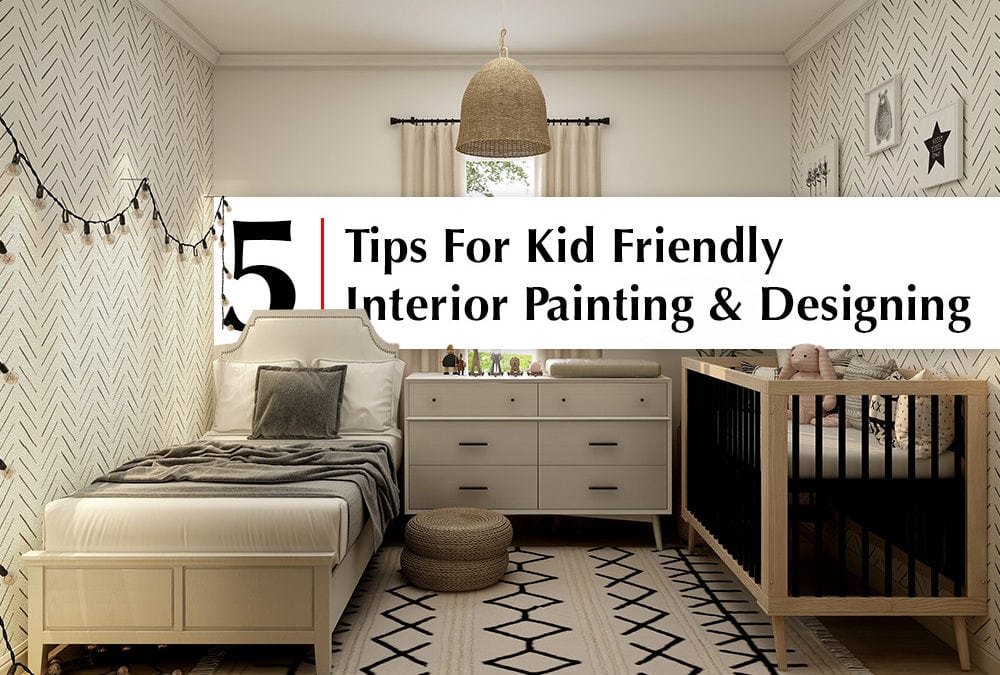5 Tips For Kid Friendly Interior Painting and Designing in La Jolla, CA

5 Tips For Dealing With Paint Chips On Your Exterior in Scripps Ranch, CA
July 3, 2021
5 Reasons Your Professional Painting Contractor Should Supply Paint in University City, CA
July 17, 20215 Tips For Kid Friendly Interior Painting and Designing in La Jolla, CA
When you’re looking to paint the interior of a room, it’s one thing if the ultimate recipient of the room or user as it were is going to be an adult or even a mix of adults and children — but if the primary user of the room is going to be a child or children, you have to have a different sort of mentality when you’re painting and preparing the room.
Children are, to say the least, a bit more sensitive, and so you have to think about their needs when you are painting and even decorating the room.
With that being the case, let’s look at five tips for kid friendly interior painting and designing in La Jolla, CA
1.Look At What Needs To Be Protected
When you’re looking to paint the interior of your child’s room, it is a good idea for you to take the time for you to also look around and to see what might need to be protected in the room.
Though you may well not think about it as such, you should look at the room from the perspective of a child and not an adult — the things that are dangerous as a child are not the same as those that are dangerous for an adult, of course.
You will have to of course make sure that the outlets are protected so that your child might get hurt — while at the same time making sure that they are accessible to you.
2.Create A Section Of The Wall For Art
In creating a room that is meant for a child or children, you might think that you have to crack down on the idea of drawing or painting on the walls — of course, this is the normal thing to do in a room that is being painted.
However, you shouldn’t think that you have to limit their creative expression — indeed, there is a perfectly good way that you’re going to be able to help get them a place on the wall where they will be able to make art.
This will come in the form of chalkboard paint — the kind of paint that transforms an average surface into an actual chalkboard upon which your child or children will be able to draw to their heart’s desire.
It is worth looking into the various techniques that are going to be necessary for painting with chalkboard paint, as they are not quite the same as using other paints in painting a room interior.
3.Use Washable Low-VOC Paint
Speaking of paint, when you’re looking at painting the rest of the room (if you’re using a bit of chalkboard paint for part of your room) you should think about the emissions of the paint that you will be applying.
You need to think about making use of low or no VOC paint for the painting of these interior walls, even more so than you would typically do when painting an interior wall.
Having low or no VOC paint is important not just for the short term life of your paintwork but for years to come, and the emissions don’t just cease after being well aired out — the quality of the air in your child’s room will be improved by using low or no VOC paint.
4.Consider Child Friendly Colors
When you paint your typical interior room, you have a lot of colors from which to choose.
This may be the case as well when you’re painting a child’s room, but it’s probably a good idea to try to limit yourself to colors that are, shall we say, a bit more friendly to children.
Depending on the age of the child that will be staying in the room, they might well have a vote or opinion on what color they are going to want in the room — and if that is the case, you should certainly give some weight to that vote but if no such vote exists, it would be good to use a warm color that is suitable for a child.
5.Sharp Edged Furniture Is Not Their Friend
Lastly (though there are of course many other considerations to be had when you are preparing a room for a child) it is important to think about the kind of furniture that you bring into a room.
As much as we want to believe that children are going to listen to us when we tell them to be careful and not run around furniture, it will still likely happen and so it is imperative to have furniture that can take a bump without injuring them.
That being the case, look for furniture with round corners and not sharp edges — children tend to get quite hurt on sharp edges.
At Peeks Brothers Painting, we use only high-quality painting products from reputable manufacturers for guaranteed durability and quality of the final paint job.
Book a FREE estimate below or call us at (858)505-1361 if you have any questions.
Related: 6 Tips To Keep Your Interior Paint Job Less Messy
7 Tips To Create A Good Accent Wall in Del Mar, CA
Top 4 Steps to Follow When Painting Interior Walls





